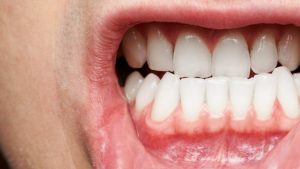 Gum disease is a common dental issue that occurs in adults of all ages. In fact, around fifty percent of adults over age 30 suffer from one form of gum disease. Gum disease is caused by hardened plaque and is an infection of the tissues that surround the teeth. It occurs when someone does not keep up with routine cleanings and does not maintain a healthy dental maintenance routine of daily brushing and flossing (paired with a tooth-healthy diet). The severity of gum disease depends on how early it is caught and how well it is treated. Gum disease can be severe if it is allowed to progress. Fortunately, not all cases are as serious as others.
Gum disease is a common dental issue that occurs in adults of all ages. In fact, around fifty percent of adults over age 30 suffer from one form of gum disease. Gum disease is caused by hardened plaque and is an infection of the tissues that surround the teeth. It occurs when someone does not keep up with routine cleanings and does not maintain a healthy dental maintenance routine of daily brushing and flossing (paired with a tooth-healthy diet). The severity of gum disease depends on how early it is caught and how well it is treated. Gum disease can be severe if it is allowed to progress. Fortunately, not all cases are as serious as others.
Do You Have Gum Disease?
The assumption that many have in regard to gum disease is that if they do not possess cavities or other dental issues, they cannot have gum disease. The danger in an assumption like this is that it can lead people to believe that they do not have to visit their dentist regularly for cleanings and checkups. The way to maintain a healthy smile is through preventative measures. If gum disease is caught early, it is reversible. This is why it is imperative that regular cleanings and checkups are not avoided. Gum disease that is left untreated, however, can become a serious issue that not only affects your gums. It can result in serious health complications. If you find that your gums bleed while brushing, feel tender, or appear to be swollen or overly red, you could be suffering from gingivitis, the earliest stage, and the only reversible stage, of gum disease.
Stage I: Gingivitis
Gingivitis is known as the earliest stage of gum disease and is caused by a plaque buildup at the gum line that causes inflammation of the gums. Even a thorough daily brushing and flossing routine is sometimes not enough to get rid of all of the plaque that builds up on the teeth; this is why seeing a dentist every six months for a teeth cleaning is necessary. A toothbrush cannot stand up to plaque that has been hardened; but specialty cleaning tools at a dental office can. Bleeding, tender, or swollen gums usually come with a diagnosis of gingivitis. The good news is that this is the one stage of gum disease that can be reversed.
Stage II & III: Periodontitis
Periodontitis occurs in two stages: slight and moderate periodontal disease. Slight and moderate periodontal disease are the second and third stages of gum disease. Receiving a diagnosis of periodontitis means that the infection affecting the gums has spread past the gum line and has started to attack bone. Signs that indicate slight or moderate periodontal disease include gum redness, the shifting or loosening of teeth, gingival (gum) recession, worsening bad breath, and bleeding after flossing or brushing. This stage can progress quickly because it is initially painless, which usually deters patients from seeking treatment when they notice bleeding or receding gums. The unfortunate reality of periodontitis is that it does not solely attack the teeth and gums. At this stage, infectious bacteria begin to enter the blood stream; this causes stress to the immune system. Treatment options for periodontitis include root planing and scaling. These treatments deep clean the area; this helps remove some of the bacteria deposits deep under the gum line. If left untreated, periodontitis progresses to advanced periodontitis, the final and most severe stage of gum disease.
Stage IV: Advanced Periodontitis
Advanced periodontitis, the final stage of gum disease, occurs when the infection in the gums and teeth deepens even more than it did in stage three. At stage four, gum disease is no longer silent. It is painful. At this stage, significant (50-90%) bone loss occurs. Signs that you have advanced periodontitis include oozing, swollen, red gums, teeth that are sensitive to cold, teeth that are loose, gum “pockets” that are over seven millimeters deep, severe halitosis, and pain when chewing. Periodontal laser therapy and/or periodontal surgery is needed when someone is suffering from advanced periodontitis. If left untreated, this stage can cause major gingival recession, increased sensitivity to cold foods or liquids, teeth spacing, and the loss of teeth. Additionally, more bacteria will be released into the blood stream, which can cause severe health issues.
Some risk factors like genetics or diabetes increase the odds that someone will get gum disease. If you have certain risk factors, it is very important that you keep up with regularly scheduled visits to your dentist. If you have been diagnosed with gum disease, remember that the diagnosis does not mean that you will lose your teeth. By adhering to the treatment plan put in place by your dentist, you can keep gum disease from progressing.

